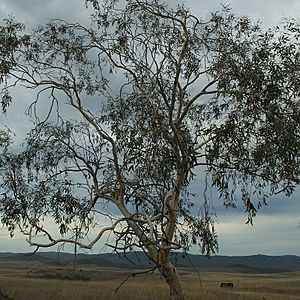Weeping snow gum facts for kids
Quick facts for kids Weeping snow gum |
|
|---|---|
 |
|
| Eucalyptus lacrimans near Cooma | |
| Scientific classification | |
| Genus: |
Eucalyptus
|
| Species: |
lacrimans
|
The Weeping Snow Gum (scientific name: Eucalyptus lacrimans) is a special kind of small tree. It only grows in New South Wales, Australia. This tree is easy to spot because of its smooth, white bark and branches that hang down, making it look like it's "weeping." It also has unique leaves, white flowers, and interesting cup-shaped fruits.
What Does It Look Like?
The Weeping Snow Gum is a tree that usually grows to be about 12 to 15 meters (around 40 to 50 feet) tall. It has very smooth, white bark, sometimes with patches of cream or light grey. Its smaller branches often have a whitish, powdery look.
This tree has a thin top part with branches that droop downwards. Young plants have leaves shaped like eggs or spears. These leaves are about 6.5 to 11 cm (2.5 to 4.3 inches) long. Older leaves are shiny green on both sides. They are shaped like spears or are slightly curved. These adult leaves are about 7 to 18 cm (2.7 to 7 inches) long.
Flowers and Fruit
The flowers of the Weeping Snow Gum are white. They grow in groups of seven, nine, eleven, or even more. Each group of flowers grows on a short stem. The flower buds themselves are oval or pear-shaped. They are about 6 to 8 mm long.
This tree usually flowers in December and January. After the flowers, the tree produces woody fruits. These fruits are shaped like a cup, cone, or barrel. They are about 7 to 11 mm long.
How It Got Its Name
The Weeping Snow Gum was officially described in 1991. Two botanists, Laawrie Johnson and Ken Hill, gave it its scientific name, Eucalyptus lacrimans. They found a sample of the tree in 1984.
The word lacrimans comes from Latin. It means 'weeping' or 'crying'. This name was chosen because of the tree's special branches that hang down, making it look like it's weeping.
Where Does It Grow?
The Weeping Snow Gum grows in certain parts of southern New South Wales. You can find it in flat, open areas that are usually treeless. These areas are called "subalpine," which means they are high up in the mountains but below the treeline. Some places where it grows include near Adaminaby, Kiandra, and Rules Point.


